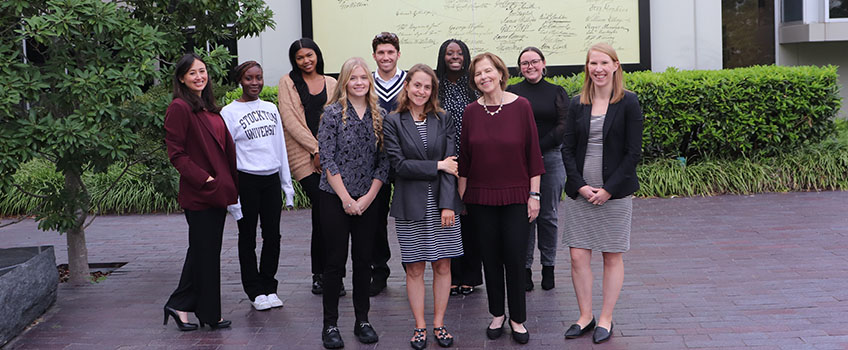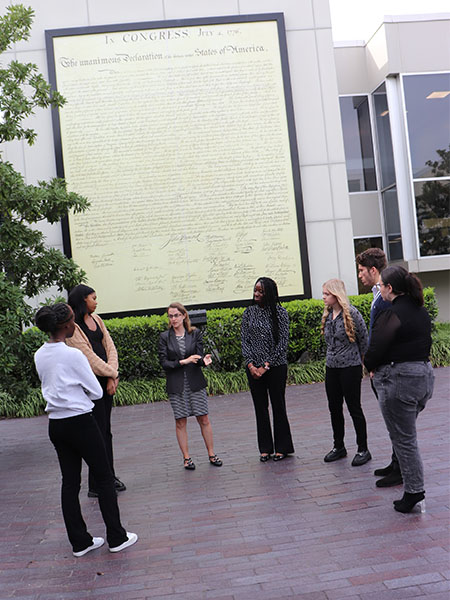Constitution Day Speaker Examines History of Reproductive Autonomy

Galloway, N.J. ‒ Constitutional scholar Mary Ziegler brought attendees of Stockton University’s annual Constitution Day event on a journey of the anti-abortion movement from the 19th century to this summer’s Supreme Court ruling overturning the Constitutional right to an abortion.
“Let’s look at how we got to the moment we find ourselves in now,” Ziegler told an audience of several hundred students, faculty and community members. “Where we are going next is uncertain.”
Ziegler, a law professor at University of California, Davis School of Law, has studied and written four books on the evolution of the anti-abortion debate.
 Until the mid-19th century, America followed the common law tradition of allowing abortion until the
time of quickening. Abortion restrictions were targeted at poisonous substances sometimes
used for the procedure, Ziegler said. That changed beginning in the mid-19th century
when the American Medical Association and other groups advocated for criminalization
of abortion.
Until the mid-19th century, America followed the common law tradition of allowing abortion until the
time of quickening. Abortion restrictions were targeted at poisonous substances sometimes
used for the procedure, Ziegler said. That changed beginning in the mid-19th century
when the American Medical Association and other groups advocated for criminalization
of abortion.
Ziegler highlighted case law and political and social strategies that brought the anti-abortion movement to the present day, partisan debate that centers on fetal personhood.
She detailed how Richard Nixon was the first in the Republican party to experiment with the anti-abortion movement. Ronald Reagan took the position making abortion illegal would appeal to the religious base who favored Democrats for economic issues, Ziegler said, adding, “Reagan made the Republicans the ‘party of life.’”
At the same time, anti-abortion leaders began to focus their work on changing the makeup of the Supreme Court. By the 1990s, they realized they needed to get justices who are indifferent to backlash of popular opinion.
Polarization deepened, and the anti-abortion movement proved their legitimacy to the Republican party by raising more and more money, Ziegler said
This movement has ushered us into the present day and the Supreme Court’s Dobbs v. Jackson Women’s Health decision in June stripping away federal protection for the right to an abortion. “This court is intent on ignoring the popular opinion when it comes to shaping its interpretation of the Constitution,” she said.
“This is a stress test for democracy,” Zeigler said. She noted voters are showing signs they may not be willing to tolerate this trend, including the increase in Democratic voter registration ahead of this year’s midterms and Kansans voted overwhelmingly to keep abortion rights in the state constitution this summer.
“The next chapter is going to be written by all of you,” Ziegler said, addressing students in the audience.
Ziegler is the author of four books on the history of American abortion law and politics. Her most recent title, “Dollars for Life: The Antiabortion Movement and the Fall of the Republican Establishment,” traces how the battle to reverse Roe v. Wade changed the rules of campaign finance, doomed the GOP establishment, and made fundamental changes to American democracy.
President Harvey Kesselman introduced Ziegler and addressed the room, “On June 25, 2022, America awoke to a different reality, one that most of you in this room have never experienced; a reality that would limit, if not eliminate,a woman'sfreedom of choice and power to choose what she will and will not do with her own body.”
The annual Constitution Day event is sponsored by the Political Engagement Project/American Democracy Project, the William J. Hughes Center for Public Policy, the Office of Service-Learning and the Office of the Provost.
Since 2006, Stockton has celebrated the signing of the Constitution with a keynote address and related events to promote a better understanding of our Constitution.
Relevant Read: An article, "How New Jersey Protects Access to Abortion in the Aftermath of Dobbs,” by Linda Wharton, professor of Political Science and Constitution Day organizer, was published recently in N.J. Law Journal magazine.
‒Story and photos by Stacey Clapp


